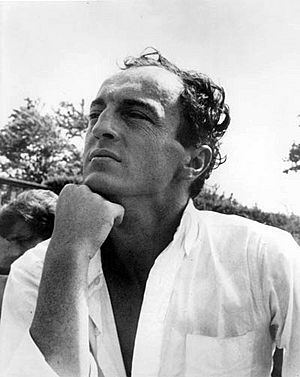Frank O'Hara facts for kids
Quick facts for kids
Frank O'Hara
|
|
|---|---|
 |
|
| Born | March 27, 1926 Baltimore, Maryland, U.S. |
| Died | July 25, 1966 (aged 40) Mastic Beach, New York, U.S. |
| Resting place | Green River Cemetery, Springs, New York, U.S. |
| Occupation | Poet, art curator |
| Alma mater | Harvard University (AB) University of Michigan (MA) |
| Literary movement | The New York School |
| Notable works | Lunch Poems |
Francis Russell "Frank" O'Hara (March 27, 1926 – July 25, 1966) was an American writer and poet. He also worked as an art critic and curator at the Museum of Modern Art in New York City. O'Hara was a key member of the New York School. This was a group of artists and writers who shared similar creative ideas.
O'Hara's poems often sounded like entries in a personal diary. They were known for being honest and direct. Poet Mark Doty described his work as "urbane, ironic, sometimes genuinely celebratory and often wildly funny." O'Hara wanted his poetry to feel like a conversation between two people. He believed poems should capture the immediate feelings of life.
His book, The Selected Poems of Frank O'Hara, won the 1972 National Book Award for Poetry. This award is one of the most important for poets in the United States.
Contents
Early Life and School Years
Frank O'Hara was born on March 27, 1926, in Baltimore, Maryland. He grew up in Grafton, Massachusetts. He went to St. John's High School.
From 1941 to 1944, he studied piano at the New England Conservatory in Boston. He loved music and was a talented piano player his whole life. During World War II, he served in the U.S. Navy. He worked as a sonarman on a destroyer ship in the South Pacific and Japan.
After the war, O'Hara used money for veterans to attend Harvard University. There, he met artist Edward Gorey. Frank O'Hara was very interested in art and music. He started writing poems and publishing them in the Harvard Advocate magazine. In 1950, he graduated from Harvard with a degree in English.
He then went to graduate school at the University of Michigan. In 1951, he earned his master's degree in English literature. While there, he won a Hopwood Award for his writing.
Life in New York City
In 1951, O'Hara moved to New York City. He shared an apartment with Joe LeSueur for many years. During this time, he also taught at The New School.
O'Hara was very involved in the art world. He wrote reviews for ARTnews magazine. In 1960, he became an assistant curator at the Museum of Modern Art. He was good friends with many famous artists. These included Norman Bluhm, Grace Hartigan, Alex Katz, and Larry Rivers.
Frank O'Hara's Poetry
Frank O'Hara's poems often told stories from his own life. However, they usually focused on his observations of New York City. He didn't often write about his past. Donald Allen, who edited O'Hara's collected poems, said that O'Hara saw his poems as a record of his life.
O'Hara once explained how he wrote his poems. He said that what happened to him, with few lies, went into his poems. He felt his experiences were just there, in whatever way he could write them. He believed poetry helped him understand life's events. It made unclear moments clearer and brought out the hidden meaning in everyday things.
During his time in the Navy and at high school, O'Hara developed a unique way of observing things. He would notice small details and often write them down. This skill helped him become an "urban poet." He could write poems quickly, capturing moments from busy city life.
Among his friends, O'Hara was known for writing poems very casually. John Ashbery said O'Hara would "dash off" poems at any time. He wrote them in his office, on the street during lunch, or even in a room full of people. Then, he would put them away and sometimes forget about them.
In 1959, O'Hara wrote a playful essay called Personism: A Manifesto. In it, he shared his ideas about how poems should be written. He joked that poetry should be like running from someone with a knife. You just run; you don't stop to think about the best way to move. He believed poems should be direct and natural.
He also said that Personism is about writing a poem to one specific person. This helps the poet focus their feelings on the poem itself. It makes the poem feel more personal and direct.
O'Hara's poetry was influenced by different art styles. These included abstract expressionism and surrealism. He was also inspired by Russian and French poets. His friend John Ashbery noted that O'Hara's idea of a poem was like a record of the creative act. This idea came from seeing the works of painters like Jackson Pollock and Willem de Kooning.
O'Hara was also influenced by American poet William Carlos Williams. Both poets used everyday language and simple statements. They shared an interest in the individual self.
Death
On July 24, 1966, Frank O'Hara was hit by a jeep on Fire Island beach. He had been riding in a beach taxi that broke down in the dark. He died the next day at age 40 in a hospital in Mastic Beach, Long Island.
He was buried in Green River Cemetery on Long Island. His longtime friend, the painter Larry Rivers, gave one of the speeches at his funeral.
Images for kids
See also
 In Spanish: Frank O'Hara para niños
In Spanish: Frank O'Hara para niños
- LGBT culture in New York City
- List of LGBT people from New York City


